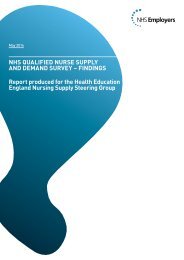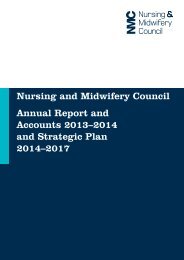Journal_1_2014_final_WEB
Journal_1_2014_final_WEB
Journal_1_2014_final_WEB
Create successful ePaper yourself
Turn your PDF publications into a flip-book with our unique Google optimized e-Paper software.
Science, Practice and Education<br />
tive infections. This lack of information about chronic<br />
ulcers may contribute to the uncertainty among physicians<br />
regarding the use of antibiotic therapy in these cases. The<br />
National Guidelines for antibiotics issued by the Norwegian<br />
Health Directory for primary health services, which<br />
is assumed to be the primary reference point for doctors<br />
who are faced with a clinical uncertainty, should therefore<br />
provide further guidance about when the prescription of<br />
antibiotics is contraindicated.<br />
Conclusion<br />
The results of the current study suggest a significant excess<br />
use of antibiotics in patients with non-healing ulcers.<br />
Mounting evidence suggests that the use of antibiotics<br />
should be reduced significantly among this population<br />
because antibiotics do not treat the underlying cause of<br />
the ulcer. A reduction of antibiotic use among this patient<br />
population will significantly reduce antibiotic resistance<br />
and health care costs associated with the side effects of<br />
antibiotics.<br />
Although the guidelines for antibiotic use should be<br />
updated and improved for use by doctors in the primary<br />
health services, research suggests that the guidelines are<br />
not read or utilized. 33 This fact argues in favour of the<br />
creation of several specialized wound healing units in<br />
Norway. A rapid referral of ulcer patients to specialists<br />
will undoubtedly raise the standards in the diagnosis and<br />
treatment of non-healing ulcers and reduce the use of<br />
antibiotics.<br />
The primary message<br />
All non-healing ulcers will be influenced to various degrees by<br />
bacteria. There is therefore no reason to take routine bacteria<br />
samples from chronic ulcers. It is most important to find out<br />
the underlying cause of the ulcer and focus on its treatment.<br />
Table 1 provides an overview of the indications for antibiotic<br />
treatment of non-healing ulcers. In such situations, bacteria<br />
samples should be taken from the ulcer. In most cases, empirical<br />
treatment will be necessary and narrow-spectrum antibiotics<br />
should be utilized to the greatest possible degree. The knowledge<br />
of the bacterial flora in different types of non-healing ulcers is<br />
therefore highly decisive. The treatment may have to be adjusted<br />
when resistance is determined.<br />
References<br />
1. Posnett J, Gottrup F, Lundgren H, et al. The resource impact of wounds on<br />
health-care providers in Europe. J Wound Care 2009;18(4):154.<br />
2. Tammelin A, Lindholm C, Hambraeus A. Chronic ulcers and antibiotic treatment.<br />
J Wound Care 1998;7:435-7.<br />
3. Edwards R, Harding KG. Bacteria and wound healing. Curr Opin Infect Sis<br />
2004;17:91-6.<br />
4. Wolcott RD, Rhoads DD. A study of biofilm-based wound management in subjects<br />
with critical limb ischaemia. J Wound Care 2008;4:145-55.<br />
5. Cutting K, Cert E, White RJ. Criteria for identifying wound infection – revisited.<br />
Ostomy Wound Manage 2005;51:28-34.<br />
6. Gjødsbol K, Christensen JJ, Karlsmark T, et al. Multiple bacterial species reside in<br />
chronic wounds: a longitudinal study. Int Wound J 2006;3:225-31.<br />
7. Howell-Jones RS, Wilson MJ, Hill KE, et al. A review of the microbiology, antibiotic<br />
usage and resistance in chronic skin wounds. J Antimicrobial Chemotherapy<br />
2005;55:143-9.<br />
8. Hill KE, Davies CE, Wilson MJ, et al. Molecular analysis of the microflora in chronic<br />
venous leg ulceration. J Medical Microbiology 2003;52:365-69.<br />
9. Bowler PG, Davies BJ. The microbiology of infected and noninfected leg ulcers.<br />
Int J Dermatol 1999;38:573-578.<br />
10. Trengrove NJ, Stacey MC, McGechie, et al.Qualitative bacteriology and leg ulcer<br />
healing. J Wound Care 1996;5:277-80.<br />
11. Ge Y, MacDonald D, Hait H, et al. Microbiological profile of infected diabetic foot<br />
ulcers. Diab Med 2002;19:1032-5.<br />
12. Schmidt K, Debus ES, Jessberger S, et al. Bacterial population of chronic crural<br />
ulcers: is there a difference between the diabetic, the venous and the arterial ulcer?<br />
VASA 2000;29:62-70.<br />
13. James GA, Swogger E, Wolcott R, et al. Biofilms in chronic wounds.<br />
Wound Repair Regen 2008;16:37-44.<br />
14. Cooper R, Okhiria O. Biofilms, wound infection and the issue of control.<br />
Wounds UK 2006;2:48-57.<br />
15. Kirketerp-Møller, Gottrup F. Bacterial biofilms in chronic wounds. Ugeskr Læger<br />
2009;171:1097.<br />
16. Sun Y, Smith E, Wolcott R, et al. Propagation of anaerobic bacteria within<br />
an aerobic multi-species chronic wound biofilm model.<br />
J Wound Care 2009;18: 426-31.<br />
17. Kirketerp-Møller K, Jensen PØ, Fazli M, et al. Distribution, organization, and ecology<br />
of bacteria in chronic wounds. J Clinical Microbiology 2008;46:2717-22.<br />
18. Dowd SE, Sun Y, Secor PR, et al. Survey of bacterial diversity inn chronic wounds<br />
using pyrosequencing, DGGE, and full ribosome shotgun sequencing.<br />
BMC Microbiol 2008;8:43.<br />
19. O’Meara S, Al-Kurdi D, Ovington LG. Antibiotics and antiseptics for venous ulcers.<br />
Cochrane Database Syst Rev 2008;23:CD003557.<br />
20. O’Meara SM, Cullum NA, Majid N, et al. Systematic reviews of wound care management<br />
(3= antimicrobial agents for chronic wounds; (4) diabetic foot ulceration.<br />
Health Technol Assess 2000;4:1-238.<br />
21. Percival SL, Woods E, Nutekpor M, et al. Prevalence of silver resistance in bacteria<br />
isolated from diabetic foot ulcers and efficacy of silver containing wound dressings.<br />
Ostomy Wound Manage 2008;54:30-40.<br />
22. Merckoll P, Jonassen TØ, Vad ME, et al. Bacteria, biofilm and honey: a study of the<br />
effects of honey on “planctonic” an biofilm-embedded chronic wound bacteria.<br />
Scand J Infect Dis 2009;41:341-7.<br />
23. Jaklic D, Lapanje A, Zupancic K, et al. Selective antimicrobial activity of maggots<br />
against pathogenic bacteria. J Medical Microbiology 2008;57:617-25.<br />
24. Bowling FL, Salgami EV, Boulton AJ. Larval therapy: a novel treatment in eliminating<br />
methicillin-resistant staphylococcus aureus from diabetic foot ulcers. Diab Care<br />
2007;30:370-1.<br />
25. Cutting KF. Addressing the challenge of wound cleansing in the modern era.<br />
Br J Nurs 2010;19(Suppl.):S24-S29.<br />
26. Horrocks A. Prontosan wound irrigation and gel: management of chronic wounds.<br />
Br J Nurs 2006;15:1224-8.<br />
27. Leaper D. European Union antibiotic awareness day relevance for wound care<br />
practitioners. Int Wound J 2010;7:314-5.<br />
28. Howell-Jones RS, Price PE, Howard AJ, et al. Antibiotic prescribing for chronic skin<br />
wounds in primary care. Wound Rep Regen 2006;14:387-93.<br />
29. Eliassen KE, Fetveit A, Hjortdal P, et al. Nye retningslinjer for antibiotikabruk i<br />
primærhelsetjenesten [New guidelines for antibiotic use in primary health service].<br />
Tidsskr Nor Legeforen 2008;128:2330-34.<br />
30. Berild D, Haug JB. Fornuftig bruk av antibiotika i sykehus. [Beneficial usage of<br />
antibiotics in hospitals] Tidsskr Nor Legeforen 2008;128:2335-39.<br />
31. Berild D. Hvordan få til riktigere bruk av antibiotika i allmennpraksis. [How to obtain<br />
more correct use of antibiotics in general practice] Tidsskr Nor Lægeforen<br />
1998;118:1172.<br />
32. Helsedirektoratet. Nasjonale faglige retningslinjer for antibiotikabruk i primærhelsetjenesten<br />
[The Health Directorate, National daily guidelines for antibiotic use in<br />
the Primary Health Service]. www.helsedirektoratet.no/vp/multimedia/archive/00078/<br />
Nasjonal_faglig_retn_78639a. (04.01.2010)<br />
33. Treweek S, Flottorp S, Fretheim A, et al. Retningslinjer for allmennpraksis – blir de<br />
lest og blir de brukt? [Guidelines for general practice – are they red and are they<br />
used?] Tidsskr Nor Lægeforen 2005;125:300-3.<br />
22<br />
EWMA <strong>Journal</strong> <strong>2014</strong> vol 14 no 1




